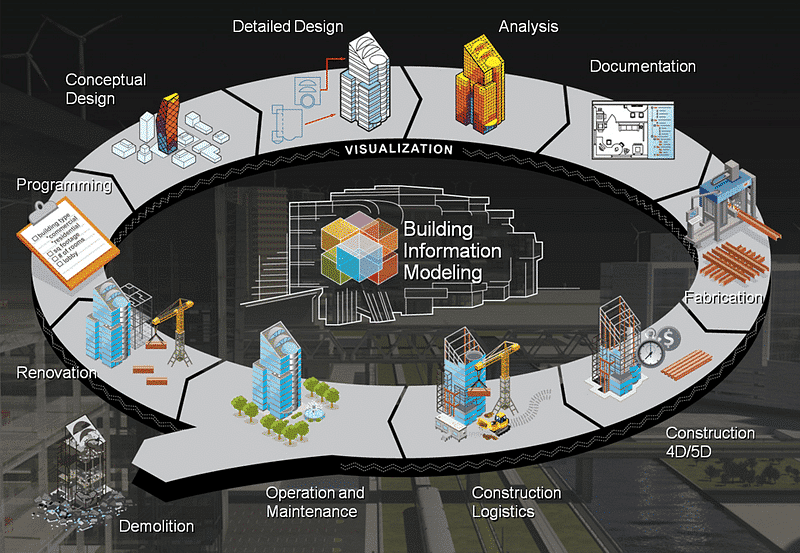
In recent years, Building Information Modeling (BIM) has emerged as a transformative force in the construction industry worldwide, and Australia is no exception. With its ability to enhance collaboration, efficiency, and sustainability throughout the project lifecycle, BIM has steadily gained momentum across construction projects in Australia. Let’s delve into the journey of BIM’s movement throughout the Australian construction landscape.
Early Adoption and Government Initiatives:
Australia recognized the potential of BIM early on and embarked on initiatives to promote its adoption. Government bodies like the Australasian Procurement and Construction Council (APCC) and the Australian Construction Industry Forum (ACIF) have been instrumental in setting standards and guidelines for BIM implementation. The National Building Information Modelling Initiative (NBIMS) aimed to drive consistency and interoperability across projects.
Integration into Building Practices:
The integration of BIM into building practices has been gradual but significant. Initially, BIM was primarily used for design and visualization purposes. However, its scope has expanded to cover the entire project lifecycle, including planning, construction, and facility management. Architects, engineers, contractors, and other stakeholders now collaborate within a shared digital environment, fostering greater coordination and communication.
Benefits Driving Adoption:
The adoption of BIM in Australian construction projects is fueled by the numerous benefits it offers. One of the primary advantages is improved project coordination and clash detection, leading to fewer errors and rework during construction. BIM’s 3D visualization capabilities enable stakeholders to better understand design intent and make informed decisions, resulting in enhanced project outcomes.
Furthermore, BIM facilitates better cost estimation and resource management, leading to improved project profitability. By simulating construction sequences and identifying potential conflicts in advance, project timelines are streamlined, reducing delays and cost overruns. Additionally, BIM’s data-rich environment supports lifecycle analysis, enabling informed decisions regarding building performance and sustainability.
Industry Collaboration and Knowledge Sharing:
A key driver behind BIM’s movement in Australia is the spirit of collaboration and knowledge sharing within the industry. Industry associations, academic institutions, and professional bodies play a vital role in promoting BIM awareness and education. Events such as conferences, seminars, and workshops provide platforms for practitioners to exchange ideas, share best practices, and learn from each other’s experiences.
Moreover, industry-wide initiatives like the Australasian BIM Advisory Board (ABAB) and BIM Excellence Awards recognize and celebrate excellence in BIM implementation, inspiring others to embrace innovative practices. The collaborative ethos prevalent within the Australian construction sector fosters a culture of continuous improvement and innovation, driving the widespread adoption of BIM.
Challenges and Opportunities:
Despite its widespread adoption, BIM implementation in Australian construction projects is not without its challenges. The transition from traditional practices to BIM-enabled workflows requires significant investment in technology, training, and cultural change. Moreover, interoperability issues between different software platforms and data formats remain a barrier to seamless collaboration.
However, these challenges also present opportunities for innovation and improvement. The development of open BIM standards and the adoption of cloud-based collaboration platforms are steps towards overcoming interoperability barriers and promoting greater data exchange. Additionally, investments in workforce training and education programs are essential to upskill the industry and harness the full potential of BIM.
Future Outlook:
The future of BIM in Australian construction projects appears promising. As technology continues to advance and stakeholders become more adept at leveraging BIM capabilities, its role is expected to further expand. Emerging trends such as digital twins, augmented reality, and machine learning are poised to revolutionize how BIM is utilized, offering new possibilities for project delivery and asset management.
In conclusion, the movement of BIM throughout Australian construction projects represents a significant shift towards digitalization and collaboration. By embracing BIM, stakeholders can unlock new efficiencies, improve project outcomes, and drive innovation across the industry. As Australia continues to embrace BIM-enabled workflows, it positions itself at the forefront of construction innovation on the global stage.
Draftech – Your Project, Our Expertise
Testimonials
Very professional and efficient organization. Delivered a great product to a tight deadline.
ACE Power
Karl and the team are very professional and have a vast knowledge of BIM coordination.
Dwayne Willaims Babinda Electrics
We had multiple large projects with tight deadlines and needed a company we could trust. The teams delivery, attention to detail and understanding of what is being designed is always executed to a high standard.
Martin O’Donovan Envar Engineers
Draftech offered a flexible and reliable approach to working collaboratively with our team. They met our expectations and quality requirements and also offered up new ideas.
Draftech have proven to be a valuable and trustworthy resource and we will continue to work with Draftech on other projects.
Simon Marsden Umow Lai
Draftech is different from others in the professionalism and features they provide.
The ability to walk through projects in real time online provides invaluable insight into problem areas and helps provide an efficient resolution on the spot without many phone calls, emails and the necessity for us to paw through countless drawings to understand the issues.
Todd Morris Manager - Air mech
Draftech were put forward to FIP Electrical as the solution to Coordinate, Model, carry out clash detection, provide Electrical Services Shop Drawings, as built documentation and completed electrical model.
Simon Thorpe FIP Electrical
In close collaboration Draftech set up all our systems and model deliverables. In this process Draftech have proven to be a valuable resource for us and demonstrated commitment, understanding and professionalism.
David Skelley DJCoalition
Draftech’s attention to detail and proactive nature throughout the project assisted us in identifying issues before becoming evident on site, saving us both time and unexpected costs.
Matt Payne PJM Engineering Services
They delivered very high quality Revit models and associated 2D documentation at key milestones, working to a tight budget and in strict accordance with the Architects’ BIM requirements.
Peter Thomas Geoff Hesford
We found Draftech’s work to be of high standard and the team delivered exactly as agreed, in fact, when we considered the project complete, Draftech put further resources into the project as they were not satisfied.
John Johnson Beca
Engaging Draftech during design gave us the tools to make smart decisions.
Hansen Yuncken Design Manager - Michael Harkins
The drafting service is timely, reliable and fit for purpose for the built environment.
Peter Harvey Harvey Industries
Draftech stands apart from other drafting services that we have previously used in their attention to detail and ability to adapt to the individual client’s requirements.
Doug Holt McCaig Aircon
I can confidently recommend Draftech as a solid and reliable supplier, and experts in their field. I look forward to working with them again in the near future.
Chris Behan Norman Disney & Young
After seeing the benefits Draftech provided us on the Townsville Hospital Redevelopment we have set up a relationship with Draftech and intend to continue to use their BIM knowledge and skills for our future projects.
Brad Lund Energy Power Systems
Draftech has no competition as they are in a class of their own.
John Boyes Babinda Electrics
Draftech Developments Drafting and Design Capabilities, in conjunction with their outstanding level of Client service and support has provided great solutions to our engineering and Drafting Design portions within our Gorgon Barrow Island Project.
Aaron Hazelton Applied Electro Systems Pty Ltd
Draftech set up necessary systems and workflows very quickly, but also setup auditable estimating and weekly cost tracking processes that we utilised, requiring little maintenance.
TOM PURDON MPM GROUP




























